Everything started with a murder mystery dinner set in the 20s. I didn’t have much time, so I took my Taschen edition of Fashion (Collection of the Kyoto Costume Institute) and started leafing through it. The flapper dresses with thousands of pearls were beautiful, but nothing I could pull of on such short notice. And then there was this simple, elegant dress: the Fortuny Delphos Dress. No complicated pattern, no complex decoration, just organic, flowing pleats and little pearls along the seams.
I can do this easily, I thought. I can get a pleated fabric in the fabric store and the expensive Murano Glass Beads can be replaced with semi-precious stones. But as you can imagine, I was wrong. Far and wide there was no pleated fabric to buy, just black pleated chiffon. But I wanted it to be gold. It wasn’t a burial after all (well actually it was, we had a murder…). My mind was already set on the Fortuny Delphos Dress. So I asked the internet how I could do the pleats myself. Fortuny kept the secret of pleating silk very well, but pleating modern polyester fabrics is actually quite easy.
Pleating by Hand
“Easy” in quotes. Because you have to create the folds by hand. In my case I used Fortuny’s method of pleating with threads. That technique creates beautiful organic wavy pleats.
I put a ruler on my fabric and set a stitch every centimeter. The thread was doubled up, so it wouldn’t break when pulling the pleats together. Every five centimeters I started a new row. So with 140cm fabric width and ca. 150cm fabric length it was 4200 stitches. ![]() I had time for some podcasts…
I had time for some podcasts…
By the way I also doubled up the fabric. Otherwise I would have to do the same amount of work for the back of the dress.
Setting the Pleats
Now setting the pleats is truly simple. You pull the threads together so you get even pleats. Maybe you have to pluck some of them into place. Then I put everything in a baking dish, added a small bowl of water and baked it for 45 minutes on 120°C. With that the fabric is heated and changes its structure permanently. In this case plastic fabric is useful for once. Fixed like this, it can even be washed.
All this information I found in a few wonderful blog posts. Around 2016 there was a challenge between the German sewing bloggers to do pleating by hand and they documented everything wonderfully. I found information here (Nahtzugabe Blog) and here (Made with Blümchen). The blogs are in German, but I’m sure you can also find English instructions.
The Result
After baking the fabric had these beautiful slightly wavy organic pleats. The golden fabric had a small stretch so the pleats are falling especially soft.
Dark Fortuny – A second Delphos Dress
While planning the photo session for the golden dress I grew more an more certain that it needed to be done with two dresses. So I made a second Fortuny Delphos Dress. This time I chose a dark purple satin. It is a bit more stiff (no stretch), so the pleats are a bit more sharp. But since the second model would be the evil twin that was a very fitting effect.
This time the process was more optimized. I pleated both fabric length at once and I fit everything into one baking dish.
Putting together the Dress & adding Pearls
The pattern of the Delphos dress is quite simple. Both lengths of fabric are sewn together along the sides and on the shoulders. That’s it. I also added a measured piece of cord to the shoulders, so they don’t move around too much. And in the original there were silk cords with the Murano Glass Beads threaded on. But I just sewed over the fabric while sewing on my semi-precious stone pearls. It almost looks like a cord as well.
The Fortuny dresses were stored curled up in hat boxes. And even in scroll form they look great. ![]()


















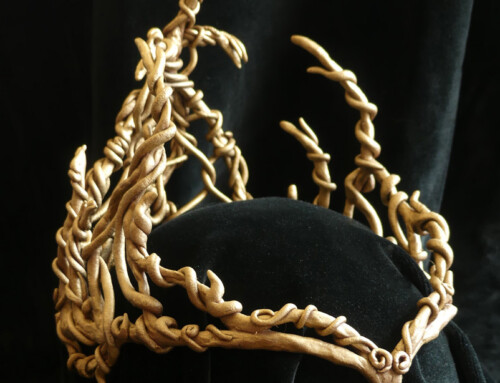
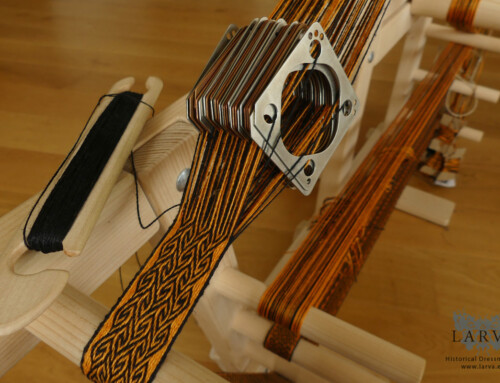
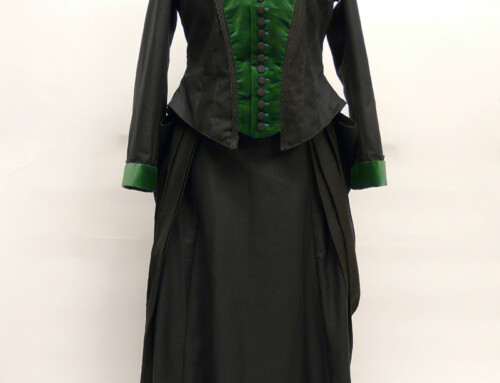
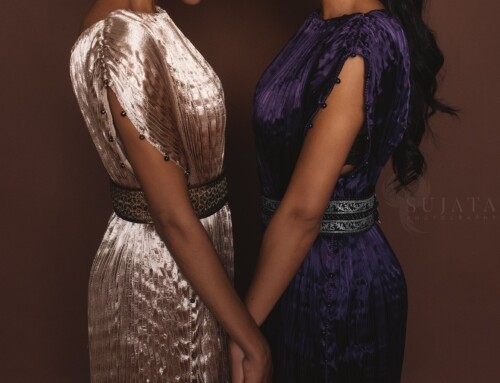
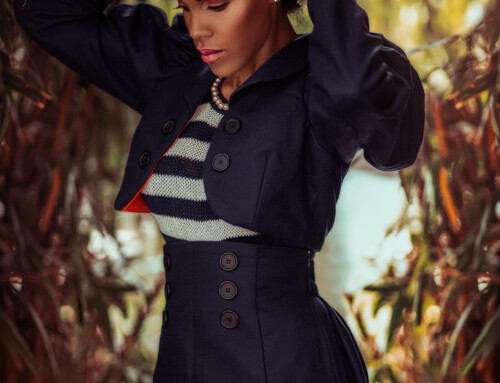
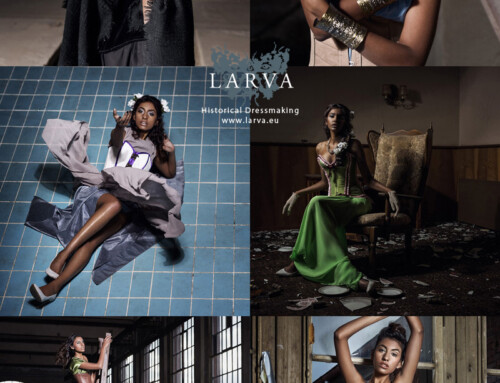

These are gorgeous! What sort of fabric did you use for the silver dress?
The gold dress is also a normal polyester satin. In that case with a little bit of stretch. It makes the pleats a bit more soft than the ones on the purple dress.
Your fabric looks fabulous. I’m ready to start but I have some questions. It sounds simple to just sew the sides and the shoulders but how wide are the shoulders? Do you pleat the fabric first and then make the dress? If so, when you sew the shoulders do you stretch out the pleats when you sew the seam? Also, for the neckline do you turn the fabric under to make the seam for the cord? How is the cord threaded? Is there one cord around the neck or back of neck and one should seam? I ordered the Fortuny book but it hasn’t arrived yet. I would really appreciate your assistance. I can hardly wait to bake my pleats! Many thanks.
Hi Nora,
Thank you for the compliment. 🙂
The first thing you do is pleating and baking the fabric. No sewing required at this point.
Then you measure your shoulder and neck widths and approximately match the relative widths to the fabric width. So a simple (slightly unrealistic) example would be you have 10cm shoulder and 20cm neck width. So your shoulders get two times 1/4 of the fabric width of 150cm. That would be 37,5cm for each shoulder. And the neck gets 1/2 the width, which would be 75cm. You can probably use the one half/one quarter division for most measurements. Just make sure the cord has your actual measurements.
Then, as you said, you stretch the fabric smooth again. First you sew the shoulder seams together, but leave a lot of extra fabric, because you will make tunnels for the cord on the front and back fabric pieces. Then pull one cord each through the whole front and back tunnels, adjust the fabric correctly (one quarter, one half, one quarter) and sew it to the cord at the endpoints and at the neck opening.
One tip: For the shoulder seams and tunnels hand stitching will work better, because it adjusts better to being pulled together. A machine seam is actually rather stiff.
Would you mind creating a post on the sewing method you used? I’m having a hard time envisioning the tunnels.
Hi there,
There’s no special technique used. I just folded the fabric over two times and stitched it. You can google for how to do a skirt hem. That’s basically the same technique.
Regards,
Sara
It sounds wonderful! I have always wanted to make a Fortuny dress. When I was studying at FIDM in Los Angeles there was little to no reference about Fortuny. This was before the internet, before they had a museum, before they even taught costuming. No teacher ever said you can set pleats with heat on polyester. How long did it take you to hand pleat the fabric? Gorgeous! Gorgeous!
Thank you for sharing and for replying to my email so quickly.
I’m glad to help. 🙂
It takes me about a day to do one length of fabric (150cm x 150cm). But I put the back and front pieces on top of each other, so I only have to do one round of pleating.
I’m about half way of pleating just one piece. I wanted to do a test before I bake the gorgeous satin I bought. Hopefully, I will get it done in time for a wedding on September 15th. If I do, it’s sold to the mother of the bride.
The dress is stunning! I was wondering if you leave the threads in the fabric after setting or do you keep them and stretch the fabric to accommodate the width needed for the dress? I’m hoping to use this method to make a Greek chiton which uses very wide panels
Hi Sara,
You have to take the threads out after setting the fabric in the oven. They would snap anyway and would look rather ugly. The pleats are quite stable on their own. Theoretically you should even be able to wash it in cold water, but I haven’t dared to do that yet with my dresses. 😉
Love,
also Sara
Good to know! Thank you Sara, 😉
Es impresionante el trabajo que hiciste!!! Muchas felicidades por tan buenos resultados!!!! Me queda una duda sobre el cocido de la tela, cuando la metes a la fuente mojas la tela, o es solamente el agua del recipiente de medio? Me llama la atención que no se queme la tela estando en el horno.
The fabric itself is NOT wet. It goes into the oven completely dry. The water is just in the second bowl.
And yes, you have to be careful that nothing burns. You should always have an eye on it. But for me the temperature was safe. The water also helps to stop the fabric from burning.
This is wonderful! I can’t wait to try this. I was wondering… how much fabric did you have to buy? It would seem to be more than double the standard…
Hi Vivian,
I used the normal fabric width (140cm) as width. So it’s two times 140cm minus a bit for the seams. This should be fine for most people, since the pleating adjusts to all sizes.
And the length is the length you want plus 15-20cm for the seams. I made both shoulder/neck and hem seam very wide. The shoulder/neck seam has a cord sewn in by hand so it keeps its size. And the hem seam I wanted to be as soft as possible.
I thought Fortuny varied the pleats so the garment copied the shape of the body and the pleats would not spread out and become less where the fabric stretched over hips, buttocks, and breasts.
The pleats were intact no matter what part of the body they covered while still following the shape of the body.
Hi Nicole,
I haven’t read that or I didn’t notice it. Do you have a source?
Adjusting the pleats to follow the form of the body would be extremely complicated and would require many panels of fabric cut in different shapes, because you have to to the pleats along the grain or they would stretch. And if you have these different pieces of fabric, how do you get continuous pleats?
There are many great pictures of the Fortuny dresses from the inside where you can see the seams and I didn’t notice anything of the sort.
Maybe it seems that way, because the dresses are always displayed on very slim mannequins and the pleats are much smaller than the one I made. Also in general the dress isn’t stretched at all when worn, because the widest part is the shoulders and it is only pinched in at the waist.
Or maybe it is a misunderstanding and it was meant that the dress could fit any body shape, because the pleats can adjust on their own.
In any case, this is a really interesting question.
Regards,
Sara